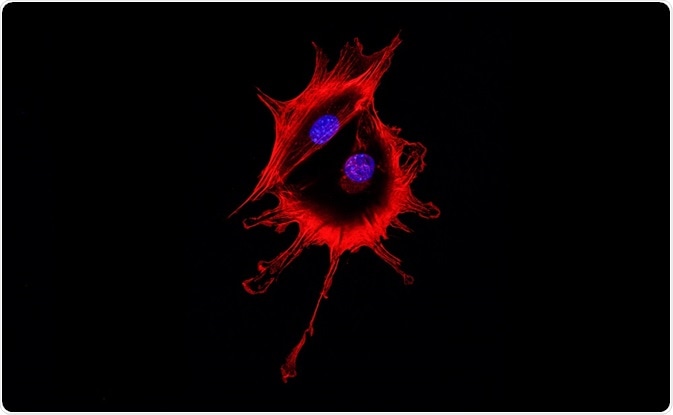To analyze experimental results from a flow cytometer, it is necessary to place “gates” in the data. Essentially, this involves putting cells with similar characteristics together, such as forward light scatter, side light scatter and marker expression.

DrimaFilm | Shutterstock
Before setting a gating strategy, it is vital to know the properties of cells to be analyzed, such as cell size, the relative expression of markers and whether artifacts are likely to have been introduced prior to running the experiment.
Examples of gating
Forward and side scatter
Forward scatter is related to size of the cell, while side scatter is related to the cell’s granularity, and this can be used to differentiate various cells and debris. Using this information, it is possible to gate the flow cytometry data so that it is possible to detect various white blood cells and distinguish those from debris.
Area and height of scatter
Doublets are when the flow cytometry detects one cell, but it was in fact two cells in close proximity. This can cause problems with data analysis, but gating by scatter height vs scatter area (typically forward), doublets can be identified and thus removed from further analysis.
What about marker expression?
Gating can also be used to identify cells which express a specific maker. For example, lymphocytes, which express CD3, can be separated from a blood sample where the red blood cells have been lysed.
These CD3+ populations can then be analyzed for further markers, such as CD4 and CD8, which are T-cell markers. Even further, the CD4/CD8 T-cells can be analyzed further for expression of CD28 and CD45RA, to differentiate between naïve, effector and memory T-cells.
Borowitz et al., used a specific gating strategy to identify leukemia cells from non-leukemia cells by using CD45 and right-angle light scatter to gate the flow cytometry. They found that leukemia cells could be identified by intermediate levels of CD45 and low right-angle light scatter, as these particular properties are only seen in about 5% of non-leukemia bone marrow cells.
A study by Nilsson used multiple gating steps to identify rare hematopoietic stem cells, the cells which give rise to all blood cells.
Does gating have to be done manually?
Nowadays, computer software tools have been developed to aid the analysis of flow cytometry data. This includes curvHDR, which was developed by Naumann et al., which can be used for semi-automatic and automatic gating for flow cytometry data.
As it can take a long time to manually analyze flow cytometry data, using a computer software can reduce the time needed. For example, if many makers are needed to differentiate the cells in the sample, this can lead to a more complex gating strategy which could possibly include re-gating selected fractions multiple times. In this case, a software would be very helpful as it would dramatically reduce the time needed to analyze the data.
Another instance where using a software may be useful is to limit the subjectivity which comes with manual analysis; a software is able to replicate a gating strategy much more accurately than if it was done manually, therefore this would mean that the data would be more comparable. Also, this would be very helpful if more than one person was carrying out the flow cytometry.
If there is interest in finding new cellular populations, using a software can aid this; as software can rely on algorithms rather than a specified gating strategy, this could highlight novel populations which may have been missed by manual gating.
Further Reading